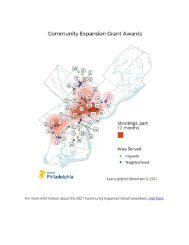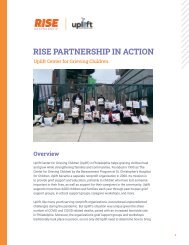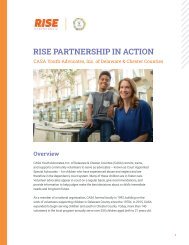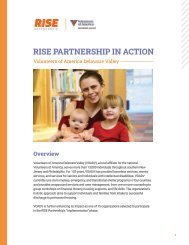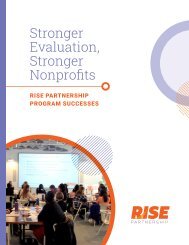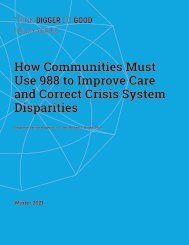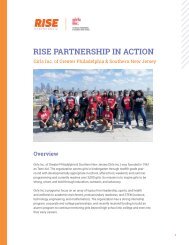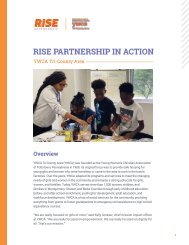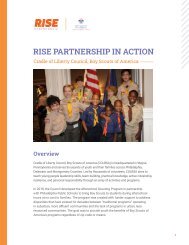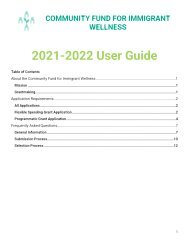Test Add using WordPress E-paper JB Local Environment
JB Local Environment
JB Local Environment
Create successful ePaper yourself
Turn your PDF publications into a flip-book with our unique Google optimized e-Paper software.
THINK BIGGER DO GOOD<br />
POLICY SERIES<br />
How Communities Must<br />
Use 988 to Improve Care<br />
and Correct Crisis System<br />
Disparities<br />
Stephanie Barrios Hepburn, J.D., and Michael F. Hogan, Ph.D.<br />
Winter 2021<br />
How Communities Must Use 988 to Improve Care and Correct Crisis System Disparities 1
Behavioral Health and the Individual Health Insurance Market
Dear Reader,<br />
As communities prepare for the 988 launch nationwide, we are prioritizing work at the local and state<br />
levels for the effective coordination of crisis response services. In partnership with national experts<br />
in behavioral health, we focus each <strong>paper</strong> on the challenge, and we hope to provide clear, actionable<br />
solutions to our audience. This <strong>paper</strong> was specifically commissioned to offer resources and serve as<br />
a tool for communities to use in developing and enhancing call centers, mobile teams, and crisis care<br />
facilities to create better outcomes for people in crises.<br />
Now is the time to address the growing behavioral health needs in our country by advancing public<br />
policies that transform the delivery of mental health and substance use disorder services and address<br />
outdated funding mechanisms.<br />
We hope you join us in advocating for stronger behavioral health policies by sharing this <strong>paper</strong> with<br />
your programmatic partners; local, state, and federal decision makers; advocacy organizations; and<br />
voters. To learn more about Think Bigger Do Good and to access the other <strong>paper</strong>s in the series, visit<br />
www.thinkbiggerdogood.org.<br />
Sincerely,<br />
Joseph Pyle, M.A.<br />
President<br />
Scattergood Foundation<br />
Founding Partner of Series<br />
Rick Kellar, M.B.A.<br />
President<br />
Peg’s Foundation<br />
Founding Partner of Series<br />
Jane Mogavero, Esq.<br />
Executive Director<br />
Patrick P. Lee Foundation<br />
Tracy A. Sawicki<br />
Executive Director<br />
Peter & Elizabeth Tower Foundation<br />
We would like to acknowledge Andrea L. Dennis, John Byrd Martin Chair of Law, University of<br />
Georgia School of Law and Mark R. Munetz, MD, Professor and Chair, Emeritus, Department of<br />
Psychiatry, Northeast Ohio Medical University as reviewers of this <strong>paper</strong> and thank them for<br />
their helpful comments.<br />
How Communities Must Use 988 to Improve Care and Correct Crisis System Disparities 3
We would like to acknowledge the following individuals for their participation in<br />
the meeting that led to the conceptualization of the <strong>paper</strong> series.<br />
Colleen L. Barry, Ph.D., M.P.P.<br />
John Hopkins Bloomberg School of<br />
Public Health<br />
Cynthia Baum-Baicker, Ph.D.<br />
The Scattergood Foundation<br />
Anita Burgos, Ph.D.<br />
Bipartisan Policy Center<br />
Thom Craig, M.P.A.<br />
Peg’s Foundation<br />
Rebecca David, M.P.H.<br />
National Council for Behavioral Health<br />
Kelly Davis<br />
Mental Health America<br />
Lisa Dixon, M.D., M.P.H.<br />
Columbia University, NY State Psychiatric<br />
Institute, and Psychiatric Services<br />
Sara Dugan, Pharm.D., B.C.P.P., B.C.P.S.<br />
Northeast Ohio Medical University<br />
Peter Earley<br />
Author & Journalist<br />
Alyson Ferguson, M.P.H.<br />
The Scattergood Foundation<br />
Richard Frank, Ph.D.<br />
Harvard Medical School<br />
Rachel Garfield, Ph.D., M.H.S.<br />
The Henry J. Kaiser Family Foundation<br />
Mary Giliberti, J.D.<br />
Mental Health America<br />
Aaron Glickman, B.A.<br />
Perelman School of Medicine,<br />
University of Pennsylvania<br />
Sherry Glied, Ph.D.<br />
NYU Wagner School of Public Service<br />
Howard Goldman, M.D., Ph.D.<br />
University of Maryland School<br />
of Medicine<br />
Pamela Greenberg, M.P.P.<br />
Association for Behavioral Health<br />
and Wellness<br />
Kimberly Hoagwood, Ph.D.<br />
New York University School of Medicine<br />
Michael F. Hogan, Ph.D.<br />
Hogan Health Solutions<br />
Chuck Ingoglia, M.S.W.<br />
National Council for Behavioral Health<br />
Rick Kellar, M.B.A.<br />
Peg’s Foundation<br />
Kelly Kelleher, M.D., M.P.H.<br />
The Research Institute at Nationwide<br />
Children’s Hospital<br />
Jennifer Mathis, J.D.<br />
Bazelon Center for Mental Health Law<br />
Donald Matteson, M.A.<br />
Pete & Elizabeth Tower Foundation<br />
Brian McGregor, Ph.D.<br />
Satcher Health Leadership Institute,<br />
Morehouse College<br />
Erik Messamore, M.D.<br />
Northeast Ohio Medical University<br />
Ben Miller, Psy.D.<br />
Well Being Trust<br />
Jane Mogavero, Esq.<br />
Patrick P. Lee Foundation<br />
Mark R. Munetz, M.D.<br />
Northeast Ohio Medical University<br />
Sandra Newman, Ph.D.<br />
John Hopkins Bloomberg School of<br />
Public Health<br />
Joseph Pyle, M.A.<br />
The Scattergood Foundation<br />
Barbara Ricci<br />
Center for High Impact Philanthropy<br />
Cheryl Roberts, Esq.<br />
Greenberger Center<br />
Victoria Romanda<br />
Peg’s Foundation<br />
Tracy A. Sawicki<br />
Peter & Elizabeth Tower Foundation<br />
Lloyd Sederer, M.D.<br />
NYS Office of Mental Health/Mailman<br />
School of Public Health<br />
Dominic Sisti, Ph.D.<br />
Scattergood Program for Applied Ethics<br />
in Behavioral Health Care & Perelman<br />
School of Medicine at the University<br />
of Pennsylvania<br />
Andrew Sperling, J.D.<br />
NAMI<br />
Kate Williams, J.D.<br />
The Scattergood Foundation<br />
Glenda L. Wrenn, M.D., M.S.H.P.<br />
180 Health Partners<br />
How Communities Must Use 988 to Improve Care and Correct Crisis System Disparities 4
Titles in the Paper Series<br />
Editors Howard Goldman, M.D., Ph.D., and Constance Gartner, M.S.W.<br />
America’s Opioid Epidemic<br />
Lloyd I. Sederer, M.D.<br />
Behavioral Health and the Individual Health Insurance Market: Preserving Key Elements of Reform<br />
Richard G. Frank, Ph.D., and Sherry A. Glied, Ph.D., M.A.<br />
Bringing Treatment Parity to Jail Inmates with Schizophrenia<br />
Mark R. Munetz, M.D., Erik Messamore, M.D., Ph.D., and Sara E. Dugan, Pharm.D., B.C.P.P., B.C.P.S.<br />
Coordinated Specialty Care for First-Episode Psychosis: An Example of Financing for Specialty Programs<br />
Lisa B. Dixon, M.D., M.P.H.<br />
COVID-19, Structural Racism, and Mental Health Inequities: Policy Implications for an Emerging Syndemic<br />
Ruth S. Shim, M.D., M.P.H., and Steven M. Starks, M.D.<br />
Employing People with Mental Illness in the 21st Century: Labor Market Changes and Policy Challenges<br />
Richard G. Frank, Ph.D., and Sherry A. Glied, Ph.D., M.A.<br />
Fentanyl and the Evolving Opioid Epidemic: What Strategies Should Policymakers Consider?<br />
Colleen L. Barry, Ph.D., M.P.P.<br />
Ho<strong>using</strong> Is Mental Health Care: A Call for Medicaid Demonstration Waivers Covering Ho<strong>using</strong><br />
Jennifer Mathis, J.D.<br />
Improving Outcomes for People with Serious Mental Illness and Co-Occurring Substance Use Disorders in Contact<br />
with the Criminal Justice System<br />
Glenda L. Wrenn, M.D., M.S.H.P., Brian McGregor, Ph.D., and Mark R. Munetz, M.D.<br />
Informed Consent: A Policy Prescription for Communicating Benefit and Risk in State Medical Marijuana Programs<br />
Erik Messamore, M.D., Ph.D., and Sara E. Dugan, Pharm.D., B.C.P.P., B.C.P.S.<br />
Integrating Mental Health and <strong>Add</strong>iction Treatment in General Medical Care: The Role of Policy<br />
Emma B. McGinty, Ph.D., M.S., and Gail L. Daumit, M.D., M.H.S.<br />
Medicaid’s Institutions for Mental Diseases (IMD) Exclusion Rule: A Policy Debate<br />
Jennifer Mathis, J.D., Dominic A. Sisti, Ph.D., and Aaron Glickman, B.A.<br />
Meeting the Needs of Justice-Involved People with Serious Mental Illness within Community<br />
Behavioral Health Systems<br />
Natalie Bonfine, Ph.D., Amy Blank Wilson, Ph.D., L.S.W., and Mark R. Munetz, M.D.<br />
New Opportunities to Improve Mental Health Crisis Systems<br />
Michael F. Hogan, Ph.D., and Mathew L. Goldman, M.D., M.S.<br />
Redesigning Federal Health Insurance Policies to Promote Children’s Mental Health<br />
Kimberly Hoagwood, Ph.D., Kelly Kelleher, M.D., M.P.H., and Michael F. Hogan, Ph.D.<br />
How Communities Must Use 988 to Improve Care and Correct Crisis System Disparities 5
Policy and Practice Innovations to Improve Prescribing of Psychoactive Medications for Children<br />
Kelly J. Kelleher, M.D., M.P.H., David Rubin, M.D., M.S.C.E., and Kimberly Hoagwood, Ph.D.<br />
Policy Recommendations to <strong>Add</strong>ress Ho<strong>using</strong> Shortages for People with Severe Mental Illness<br />
Sally Luken, M.A.<br />
Preventing Risk and Promoting Young Children’s Mental, Emotional, and Behavioral Health<br />
in State Mental Health Systems<br />
Kimberly Eaton Hoagwood, Ph.D., Kelly Kelleher, M.D., Nathaniel Z. Counts, J.D., Suzanne Brundage, M.Sc., and Robin<br />
Peth-Pierce, M.P.A.<br />
Preventing Suicide Through Better Firearm Safety Policy in the United States<br />
Jeffrey W. Swanson, Ph.D.<br />
Systemic, Racial Justice–Informed Solutions to Shift “Care” From the Criminal Legal System to the<br />
Mental Health Care System<br />
Sarah Y. Vinson, M.D., and Andrea L. Dennis, J.D.<br />
Suicide Is a Significant Health Problem<br />
Michael F. Hogan, Ph.D.<br />
The Current Medicaid Policy Debate and Implications for Behavioral Healthcare in the United States<br />
Rachel Garfield, Ph.D., M.H.S., and Julia Zur, Ph.D.<br />
Youth Suicide Is Increasing: Modest Actions Taken Now Can Save Lives<br />
Michael F. Hogan, Ph.D.<br />
Find the <strong>paper</strong>s online at www.thinkbiggerdogood.org<br />
We are grateful for the partnership that allows <strong>paper</strong>s in this series to appear in<br />
Psychiatric Services, a peer-reviewed monthly journal of the American Psychiatric<br />
Association. Content can be viewed at ps.psychiatryonline.org.<br />
How Communities Must Use 988 to Improve Care and Correct Crisis System Disparities 6
How Communities<br />
Must Use 988<br />
to Improve Care<br />
and Correct Crisis<br />
System Disparities<br />
Stephanie Barrios Hepburn, J.D.<br />
Chief Content Officer, RI International<br />
Editor in Chief, #CrisisTalk<br />
stephanie.hepburn@riinternational.com<br />
Michael F. Hogan, Ph.D.<br />
Department of Psychiatry<br />
Case Western Reserve<br />
dr.m.hogan@gmail.com<br />
How Communities Must Use 988 to Improve Care and Correct Crisis System Disparities 7
1<br />
988: A New Opportunity<br />
Most people cannot remember a time before 911, when people in an emergency dialed 0 for<br />
an operator or directly called or ran to the nearest police or fire station. For years, behavioral<br />
health 1 advocates and experts have pushed for a three-digit number for mental health,<br />
substance use, and suicide crises—a number that would be on par with and, hopefully, as<br />
ubiquitous as 911 is for medical emergencies. And, like 911, the innovation wouldn’t be just a<br />
number. Instead, experts envisioned a well-funded, interconnected emergency system for<br />
behavioral health crises, with a continuum of services and supports that would help foster<br />
parity while reducing stigma and criminalization.<br />
The United States took a vital step toward this goal in July 2020, when Federal<br />
Communications Commission (FCC) Chairperson Ajit Pai (1) announced a nationwide threedigit<br />
number that would “effectively establish ‘988’ as the ‘911’ for mental health emergencies.”<br />
Under Pai’s guidance, the FCC adopted rules requiring all phone service carriers to direct<br />
988 calls by July 16, 2022, to the existing National Suicide Prevention Lifeline (2), which the<br />
Substance Abuse and Mental Health Services Administration (SAMHSA) funds. The Lifeline,<br />
run by Vibrant Emotional Health, is a network of about 200 2 accredited call centers. All<br />
988 calls—and, potentially, texts—will go to the centers, filtered by area code unless callers<br />
press 1 to reach the Veterans Crisis Line, the national crisis call system operated by the<br />
Department of Veterans Affairs. Three months after Pai’s announcement, Congress passed<br />
the National Suicide Hotline Designation Act of 2020 (3), supporting 988 implementation<br />
and allowing states to apply a monthly telecom customer service fee to pay for 988-related<br />
services. Many communities across the United States, increasingly aware of gaps in the<br />
overall crisis response continuum, had already started or planned to re-engineer and build<br />
out their systems, including mobile crisis services and crisis facilities. Expansion plans have<br />
also included the evolution of crisis call centers into hubs that can dispatch mobile crisis<br />
teams and provide real-time data on and access to crisis facilities. As states move toward 988<br />
readiness, communities must capitalize on this momentum to meet local needs.<br />
This <strong>paper</strong> describes examples and new resources to improve the care of people experiencing<br />
behavioral health crises. We focus on imminent opportunities and provide links to resources<br />
helpful in regional or local crisis redesign efforts.<br />
1<br />
The term behavioral health has evolved to include both mental and substance use disorders.<br />
2<br />
As of November 2021, there were 194 Lifeline accredited call centers, with seven more in the final onboarding phase.<br />
How Communities Must Use 988 to Improve Care and Correct Crisis System Disparities 8
2<br />
Change the Culture<br />
In recent years, crisis care reform has expanded to include not only addressing<br />
long-standing problems in providing appropriate care to people in mental health<br />
crises but also ensuring that people experiencing substance use crises receive<br />
such care. This expanded framework for reform has been accompanied by greater<br />
recognition of inequities associated with reliance on law enforcement as the de<br />
facto responder for behavioral health and quality-of-life crises. Tools such as the<br />
Sequential Intercept Model, developed by Munetz and Griffin (4), and resources<br />
promoted by SAMHSA’s GAINS Center, as well as Stepping Up (5), a national<br />
initiative to reduce the number of people with mental illness in jails, have helped<br />
advance this cause. However, a confluence of factors has magnified the need<br />
for change, including the COVID pandemic and increased awareness of racial<br />
and ethnic disparities in law enforcement interactions brought into focus by the<br />
murder of George Floyd by four Minneapolis police officers in May 2020.<br />
As a result, leaders have leaned further into finding alternatives to justice system<br />
entanglement for people with behavioral health and quality-of-life challenges<br />
and reforming crisis systems to better meet people’s needs. This is especially<br />
vital for supporting marginalized and disenfranchised populations, who are<br />
disproportionately most at risk of police interactions turning deadly (6). According<br />
to November 2021 data from the Washington Post’s police shooting database (7),<br />
of people killed in the United States by a police officer in the line of duty since<br />
January 1, 2015, 23% were Black, 16% were Hispanic, and 23% were identified as<br />
having a mental illness. These populations are also more at risk of incarceration.<br />
For example, in Harris County, Texas, the Sheriff’s Department maintains a jail<br />
“dashboard” that gives information on each inmate (8). On November 13, 2021,<br />
Black and Hispanic people disproportionately made up the jail population—51%<br />
and 24%, respectively. The majority of inmates, 77%, were experiencing mental<br />
health challenges, and roughly 86% were in pretrial detention, meaning that they<br />
were in jail awaiting due process. Ed Gonzalez, Harris County Sheriff, told the<br />
Texas Standard that the county’s jail is “the largest mental health facility in the<br />
state” (9).<br />
How Communities Must Use 988 to Improve Care and Correct Crisis System Disparities 9
Box 1 / High-Leverage Opportunities to Improve Crisis Care in Your Community<br />
1<br />
2<br />
3<br />
4<br />
Work to divert 911 calls<br />
Help your 988 call center<br />
Bring stakeholders<br />
Develop your marketing<br />
from PSAPs to your<br />
“upgrade” to a crisis care<br />
together to plan for a<br />
plan. Most states plan to<br />
region’s 988 call center.<br />
hub with the ability to<br />
regional crisis receiving<br />
slowly roll out 988, not<br />
An incremental, staged<br />
dispatch mobile teams and<br />
facility that will accept<br />
simply flip a switch on<br />
approach may be best,<br />
maintain real-time data on<br />
direct drop-offs from first<br />
July 16, 2022. However,<br />
such as starting with<br />
crisis services access.<br />
responders and bypass<br />
states are beginning to<br />
physical or virtual co-<br />
overloaded emergency<br />
develop their marketing<br />
location of behavioral<br />
departments.<br />
plan, with some, such<br />
health crisis professionals<br />
as Georgia, hiring a<br />
at 911 call centers.<br />
consulting firm to handle<br />
their 988 communications.<br />
Crisis Care Services Shouldn’t Come in a Police Car<br />
As communities across the nation debate the role of police<br />
and explore alternative response programs, Ron Bruno, a<br />
retired Utah police officer and executive director at Crisis<br />
Intervention Team (CIT) International (10), has pointed out<br />
that while police have a critical role in mental health crisis<br />
response, it is in the position of support and only when<br />
necessary. He notes, “We have to challenge the belief that<br />
mental health crisis services must come in a police car” (11).<br />
According to Bruno, most calls to 911 don’t require a police<br />
response, and call takers can transfer calls to a crisis line<br />
where “the majority of calls, 80% and upward, are resolved<br />
at that level, and there’s no need for police involvement.”<br />
The CIT program, developed by now-retired Memphis Police<br />
Maj. Sam Cochran, is a first-responder, police-based crisis<br />
intervention designed to reduce the role of law enforcement<br />
in behavioral health crisis response. The program in Memphis<br />
was one of the earliest and most critical innovations to<br />
address the criminalization of mental health, and it was<br />
sparked by a lethal police interaction that took place more<br />
than three decades ago. In 1987, police officers in Memphis<br />
responded to a 911 call from a mother worried her son would<br />
kill himself (12). Joseph DeWayne Robinson had cut himself<br />
120 times with a butcher’s knife. He had schizophrenia and<br />
was experiencing paranoia. When police officers arrived at<br />
LeMoyne Gardens public ho<strong>using</strong> project, the perimeter was<br />
tight, and they asked Robinson to drop the knife. He didn’t.<br />
The officers shot and killed him. They said Robinson lunged<br />
at them, but witnesses said he did not. The killing resulted in<br />
community outrage and prompted racial bias charges against<br />
the city’s administration. Robinson was Black, and the two<br />
officers were White.<br />
Following the police killing of Robinson, Maj. Cochran led a<br />
diverse stakeholder effort and law enforcement commitment<br />
to develop teams specially trained to work with people in a<br />
mental health or substance use crisis. However, although<br />
many communities have emphasized the police training<br />
approach, they have often focused less on another core<br />
component of the model: community partnership between<br />
law enforcement, behavioral health, people with lived<br />
expertise, and other advocates. Maj. Cochran has said that the<br />
platform is designed, through robust collaboration, to remove<br />
system barriers that prevent people with mental illness from<br />
getting the help they need (13). That includes ensuring that<br />
there are crisis facilities where law enforcement can, obstaclefree,<br />
take people in distress for care—instead of booking and<br />
custody. These facilities are an essential component of a<br />
comprehensive behavioral health crisis system that continues<br />
to be absent in many communities.<br />
How Communities Must Use 988 to Improve Care and Correct Crisis System Disparities 10
The Council of State Governments’ Justice and Mental Health<br />
Collaboration Program also fosters partnership between<br />
criminal justice and behavioral health systems (14). Integrated<br />
into the program are 14 peer-to-peer learning sites that have<br />
demonstrated best practices when responding to behavioral<br />
health issues and houselessness. Linking crisis systems,<br />
starting with 911, should be a primary target for communities<br />
as they plan 988 implementation. Less examined, but also<br />
vital, is how 988 will connect to social service numbers for<br />
people experiencing quality-of-life challenges—sometimes<br />
311 or 211, depending on the community—to ensure linkage<br />
beyond “a warm handoff.”<br />
Link and Partner with Intersecting Systems<br />
Historically, states and counties have developed behavioral<br />
health crisis systems without input from the community<br />
and essential partners and then expected them to fall in<br />
line. To ensure that system reform does not repeat the<br />
same mistakes, partnership and cooperation must be part<br />
of the 988 system’s development at every step of planning<br />
and implementation. That doesn’t mean considering only<br />
the populations a system serves, but instead convening<br />
a work group that includes these populations along with<br />
other stakeholders—law enforcement, hospitals and<br />
emergency departments, state and local behavioral health<br />
officials, Lifeline-988 call centers, judges, prosecutors,<br />
public defenders, social workers, peers, advocates, and<br />
representatives from city, county, and state agencies.<br />
Using a community strategic planning tool to inform its<br />
recommendations, the work group should track how people<br />
with behavioral health and quality-of-life challenges<br />
come into contact and move through the criminal justice<br />
system. For example, the Sequential Intercept Model does<br />
just that at critical intercept points: community services,<br />
law enforcement, initial court hearings and detention,<br />
jails and courts, reentry, and community corrections (15).<br />
Communities, such as Los Angeles County, have used a<br />
modified version of the model (16), which adds intercept<br />
00 (17), foc<strong>using</strong> on a holistic, community-based, systemof-care<br />
infrastructure and recommendations to prevent<br />
justice system involvement and for community reentry<br />
after incarceration. In addition, many communities already<br />
have cross-system and consumer-family representation<br />
work groups and collaborations through participation in<br />
the previously mentioned Stepping Up initiative, a national<br />
effort sponsored by the Council of State Governments (5).<br />
The initiative has four key jail diversion measures for people<br />
with mental illness: reduce the number of people booked<br />
into jail, shorten their average length of stay, increase their<br />
connections to treatment, and lower recidivism rates. Other<br />
communities are turning to their CIT steering committees,<br />
which seek to grow the program’s efforts beyond police<br />
training and toward a more systematic approach. Some<br />
communities are doing all three. These efforts provide a<br />
strong launching pad for implementing 988 to strengthen<br />
crisis response.<br />
How Communities Must Use 988 to Improve Care and Correct Crisis System Disparities 11
3<br />
988-911 Partnership:<br />
Crack Open the<br />
911 “Black Box”<br />
What has led to the high involvement of police in psychiatric and quality-of-life crises<br />
is multifold and based on precedent, expectation, and the vast underfunding and<br />
insufficient reimbursement of behavioral health and community-based services. Police<br />
also become involved because 911 is an easy-to-remember number that people know<br />
to call in an emergency, and public-safety answering points (PSAPs)—such as 911 call<br />
centers—are GPS-enabled, allowing first responders to respond quickly. Although 911<br />
is the number people dial to reach police, fire, and emergency medical services, it has<br />
long been the number people call expecting a law enforcement response, even when<br />
the call is nonemergency and there has been no crime. In fact, when 911 launched in<br />
New York City on July 1, 1968, calls for a law enforcement response spiked by over 40%<br />
(going from 12,000 to 17,000 calls a day [18])—and more than half were nonemergency<br />
(19). Years later, a study analyzed 1977 data from over 26,000 911 calls to police in<br />
Rochester, St. Louis, and Tampa-St. Petersburg (20). The researchers found that most<br />
calls were for nonemergencies. Less than 20% were for what callers perceived to<br />
be criminal incidents of any kind. Yet callers continue to depend on an in-person<br />
police response.<br />
Many 911 callers are not people in a behavioral health crisis themselves, but instead<br />
they are third-party callers reporting “strange behavior.” This dynamic creates a system<br />
ripe for blind spots because of its dependence on an observer, a viewpoint easily<br />
influenced by a person’s biases, to identify what another person might be experiencing.<br />
Dr. Rebecca Neusteter, executive director at University of Chicago Health Lab and<br />
former policing program director at the Vera Institute of Justice, has said that the<br />
nature of the 911 call taker role is “to hear one person’s perspective of a situation and<br />
treat it as though it’s true” (19). An analysis of more than 18 months of 911 call data in<br />
Austin, Texas—roughly one million calls—revealed that 64% of mental health–related<br />
calls originated from disturbance and trespassing incidents and requests for welfare<br />
checks on people (21). A similar study in Atlanta found that of 3.4 million 911 calls<br />
in the metropolitan area over 3.8 years, 600,000 calls (18.4%) may have been suitable<br />
for diversion from 911 (22). The researchers labeled these calls “calls of focus.” Most<br />
How Communities Must Use 988 to Improve Care and Correct Crisis System Disparities 12
were coded as “suspicious person,” “directed patrol,” “criminal<br />
trespass,” “street/sidewalk hazard,” “person injured/down,”<br />
“demented person,” or “public indecency.” None were coded<br />
as mental or behavioral health. Also, a multicity 911 analysis<br />
conducted by Dr. Neusteter and her former colleagues at the<br />
Vera Institute of Justice revealed that call takers were unlikely<br />
to classify calls the same way (23). The lack of uniformity<br />
and transparency of 911 protocols and the local nature of 911<br />
PSAPs make it challenging to divert people experiencing<br />
mental health, substance use, or quality-of-life crises.<br />
It is likely, at least in part, that because of the obscurity of<br />
911 call coding, criminal justice diversion has primarily<br />
focused on pre-arrest diversion as the starting point, with<br />
communities turning to co-responder models (teams that<br />
comprise a police officer or emergency medical technician<br />
partnered with a behavioral health professional) and<br />
alternative street responder teams. However, diverting people<br />
experiencing behavioral health or quality-of-life crises from a<br />
law enforcement response requires understanding what leads<br />
to police involvement in the first place, which often happens<br />
at the 911 call center, making it dire that communities crack<br />
open their 911 “black box” (23). With a 911-988 partnership,<br />
calls to 911 can be diverted to 988, and crisis resources—such<br />
as mobile crisis teams—can be dispatched instead of police<br />
officers. Los Angeles, Harris County, Austin, and Tucson are<br />
already working to improve linkages between their local 911<br />
PSAPs and behavioral health crisis call centers. Sometimes<br />
that includes physical or virtual co-location of call counselors<br />
at 911 call centers, who are integrated into the PSAP<br />
computer-aided dispatch system, commonly called CAD.<br />
For example, in Austin, Integral Care’s Expanded Mobile<br />
Crisis Outreach Team (EMCOT) clinicians are physically<br />
co-located at the Combined Transportation, Emergency, and<br />
Communications Center/Austin Police Department 911 Call<br />
Center and work on the same platform (24). When a person<br />
dials 911, the call taker asks, “Are you calling for police, fire,<br />
EMS, or mental health services?” The integration allows<br />
call counselors to see incoming calls and identify those<br />
with a behavioral health nexus that they can divert. Before<br />
integration with the 911 center’s communication system,<br />
Marisa Aguilar, the EMCOT’s program manager, said call<br />
takers were transferring calls over to the service by phone,<br />
and “most calls were getting dropped” (24). Since co-location,<br />
the Austin program has diverted roughly 85.4% of behavioral<br />
health calls from law enforcement and transferred them to<br />
their EMCOT clinicians (25).<br />
Physical co-location of call counselors at a 911 PSAP, such<br />
as in Harris County, Texas, helps bridge the gap between<br />
two very different disciplines as they develop trust through<br />
partnership, continued communication, and a streamlined<br />
feedback loop. The Harris County program also includes<br />
dedicated mobile teams to respond to diverted 911 calls (26).<br />
However, physical co-location is not an option everywhere,<br />
especially in rural communities and those with a high<br />
number of PSAPs. Los Angeles County, for instance, has 78<br />
primary 911 PSAPs. Although county leaders plan to co-locate<br />
their 988 call center with the local PSAPs (27), they will do so<br />
virtually (28).<br />
In Tucson, the COVID pandemic forced call counselors to<br />
shift to virtual co-location temporarily. However, it created an<br />
opportunity for more call takers. Crisis line leads in Tucson<br />
are now trained to pick up calls from the Public Safety<br />
Communications Department if the two crisis professionals<br />
trained on the CAD dispatch system are already on 911 calls.<br />
The diversion program plans to increase the number of call<br />
takers on the crisis line who are CAD-trained so it can take<br />
on even more 911 calls and is actively looking to expand its<br />
virtual co-location to other 911 PSAPs in Arizona. During<br />
the pandemic, the stabilization rate after a dispatched<br />
Community Bridges or Community Health Associates mobile<br />
crisis team has interfaced with a person in crisis has hovered<br />
around 85%, regardless of whether the person called 911 or the<br />
crisis line (29). However, more 911 calls—roughly 60% of the<br />
911 calls that the team diverts—result in a mobile crisis<br />
team dispatch. When people dial 911, they expect an inperson<br />
response.<br />
How Communities Must Use 988 to Improve Care and Correct Crisis System Disparities 13
4<br />
Build a Comprehensive<br />
Crisis Continuum<br />
Designing a robust 988-911 partnership can be maximized only if there is a<br />
reliable corresponding behavioral health crisis system to which first responders<br />
can divert people. However, this is not the case in many communities. When<br />
law enforcement does reach out to crisis care providers, they often experience<br />
inconsistent mobile crisis unit response or get tangled in a web of provider<br />
exclusion, such as when the provider deems the person too aggressive, acute,<br />
or intoxicated. Or providers require police officers to first take the person to a<br />
hospital emergency department, commonly known as the emergency room, to get<br />
“medical clearance”—a medical evaluation of a patient whose symptoms appear<br />
to be psychiatric. Communities should address this barrier in their crisis system<br />
redesign by building capacity for brief medical assessment. Unfortunately, these<br />
hurdles deter first responders from reaching out and continue to thrust them into<br />
the role of de facto behavioral health responder while taking them away from their<br />
primary responsibilities.<br />
Box 2 / Special Population: Veterans and Military<br />
Suicide rates among veterans and active-duty service members exceed<br />
national norms. The military branches and the Department of Veterans<br />
Affairs (VA) have done more than most civilian organizations and health<br />
systems to respond. But most veterans do not use VA health care, and<br />
their needs are often not recognized by mainstream providers. To address<br />
this problem, the VA and SAMHSA have launched a national initiative and<br />
technical assistance center (42). To aid in this effort, the VA is preparing<br />
to launch a $174 million grant program focused on preventing veteran<br />
suicide (43). Communities that are especially interested in this population<br />
should consider this new program.<br />
How Communities Must Use 988 to Improve Care and Correct Crisis System Disparities 14
Although law enforcement has been the default behavioral<br />
health crisis responder, the emergency department has been<br />
the default provider. Because most communities do not have<br />
a robust behavioral health crisis continuum, the emergency<br />
department is the go-to place for people with a broad range<br />
of mental health needs, including those who have run out of<br />
medication or do not have anywhere else to turn. But when<br />
they get there, they wait. People wait for urgent psychiatric<br />
care and then wait for continued care, sometimes placed in<br />
an observation room or strapped to a gurney in the hallway.<br />
Wait times in the emergency department can be hours or<br />
days—sometimes weeks or months.<br />
This trend in which people who visit an emergency<br />
department and then wait a long time for treatment,<br />
commonly known in the mental health field as psychiatric<br />
boarding, has drawn nationwide attention because of a<br />
landmark case in Washington State. In 2014, the Washington<br />
State Supreme Court held psychiatric boarding to be<br />
unlawful, ruling that the state’s Involuntary Treatment<br />
Act “does not authorize psychiatric boarding as a method<br />
to avoid overcrowding certified evaluation and treatment<br />
facilities” (30). The Seattle Times reported that people were<br />
detained for days, sometimes months, while bound to<br />
hospital beds parked in emergency department hallways (31).<br />
Usually, they were given medication. Sometimes they were<br />
not. The experience of psychiatric boarding is traumatic, and<br />
the long delays can adversely affect a person’s employment,<br />
finances, personal life, and recovery. During the pandemic,<br />
these trends have worsened because of an increased<br />
proportion of emergency department use for behavioral<br />
health stress (32), especially among children (33).<br />
Box 3 / Special Population: LGBTQ Youth<br />
Rates of distress and suicide attempts are higher<br />
among LGBTQ youth, with rates of suicide attempts<br />
two to four times as high as among other youth. The<br />
Trevor Project (44) is the leading crisis intervention<br />
and suicide prevention organization for young<br />
LGBTQ people up to 24 years old, providing 24/7 text/<br />
chat support (accessed by texting START to 678-678)<br />
and hotline support at 1-866-488-7386.<br />
To foster systemic change, communities must create 911-<br />
988 call center partnerships and develop a feedback loop<br />
between PSAPs and behavioral health crisis services. And<br />
at every potential entry point, first responders must be able<br />
to easily and quickly connect people to treatment. Also,<br />
communities need to build out their behavioral health crisis<br />
continuum—call center hub, mobile crisis services, and crisis<br />
receiving and stabilization facilities—and scaffold robust<br />
and efficient pathways within and between systems, so that<br />
first responders and providers within the system know how<br />
to best connect people to rapid and adequate care—and so<br />
that people in crisis know whom to contact and where to go.<br />
The nationwide 988 designation is not simply an easy-toremember<br />
number to the nation’s mental health, substance<br />
use, and suicide crisis hotline. To solve urgent issues and<br />
emergencies in crisis care, communities must redesign their<br />
crisis systems and turn to evidence-based innovations and<br />
best practices.<br />
How Communities Must Use 988 to Improve Care and Correct Crisis System Disparities 15
5<br />
Open Doors and<br />
Build Hubs<br />
In February 2020, SAMHSA published national guidelines for mental health and<br />
substance use crisis care (34). This best-practices toolkit identifies four core elements<br />
that an integrated crisis system needs: regional or statewide crisis call centers that<br />
coordinate in real time, centrally deployed 24/7 mobile crisis services, 23-hour crisis<br />
receiving and stabilization programs, and essential crisis care principles and practices.<br />
Threaded throughout the guidelines is the recommendation for partnership with first<br />
responders and a “no wrong door” approach for rapid diversion, in which crisis service<br />
providers have a no-refusal policy, accepting all referrals, walk-ins, and first responder<br />
and mobile crisis team drop-offs.<br />
What 911 is for medical crises, the regional or statewide 988 call center will become<br />
for behavioral health emergencies. The envisioned capacity is sometimes called a call<br />
hub or “care traffic control.” According to a 2018 survey of Lifeline centers, nearly 98%<br />
of crisis calls to accredited centers are de-escalated, diverting people from costly and<br />
highly restrictive law enforcement and emergency medical service responses (35). To<br />
divert calls from law enforcement, other first responders, and the emergency department,<br />
call hubs must be well connected with 911 call centers, first responders, and all<br />
other parts of the behavioral health crisis system, such as mobile crisis services and<br />
23-hour crisis receiving and stabilization programs.<br />
As states plan to build their own regional or statewide call hub, many seek to emulate<br />
features of the Georgia Crisis and Access Line call center, commonly called GCAL.<br />
The hub is data driven and uses technology to coordinate care, giving people a single<br />
entry point into the behavioral health and developmental disabilities crisis systems.<br />
The center provides phone, text, and chat intervention services, and call counselors<br />
can make urgent and emergency appointments for callers. In addition, call counselors<br />
have real-time access to available crisis and detox beds throughout the state and 24-<br />
hour mobile response coverage within 100 miles of every Georgia community, <strong>using</strong><br />
GPS, if needed, to dispatch a mobile crisis team to the person in crisis.<br />
Determining potential 988 call volume is still a bit of a guessing game. It is clear,<br />
though, that maximizing 988 will depend on marketing—so that people call 988 instead<br />
of 911—and how well communities use 988 to redesign their crisis system, with<br />
improved interconnections within the system and between 988 and the 911 emergency<br />
response system and first responders.<br />
How Communities Must Use 988 to Improve Care and Correct Crisis System Disparities 16
6<br />
Become Mobile<br />
Another vital diversion target is to ensure that there is an alternative to law enforcement<br />
handling crisis call-outs. Mobile crisis teams, often including a behavioral health<br />
professional and a peer specialist, should be the first line of defense when people<br />
in crisis need more than telephonic support. Coordination and the development of<br />
shared protocols can clarify the circumstances in which the mobile crisis team—<br />
instead of 911 first responders—can handle a call and those situations (e.g., presence of<br />
a weapon at the crisis) where co-responding is appropriate. In Tucson, when integrated<br />
call counselors at the 911 call center need to dispatch a mobile crisis team, they<br />
tap into the crisis line’s dispatch optimization tool, an app connected to its electronic<br />
health record system. The app is GPS-enabled mobile phone software that allows call<br />
takers to see the location and status of each mobile crisis team and deploy one that<br />
is available and closest to the person in crisis (6). In addition, teams are color coded:<br />
green means a team is available, yellow means a team is activated and headed to a<br />
call, and gray is when a team is offline. However, across the United States, mobile crisis<br />
services are insufficient and unevenly developed, and—unlike the examples described<br />
in Austin, Harris County, and Tucson—they are often not connected to 911.<br />
Box 4 / Special Population: Children and Adolescents<br />
Rates of distress among adolescents were on the rise even before the<br />
COVID pandemic. During the pandemic, rates of suicide attempts have<br />
increased most strikingly among adolescents ages 12 to 17, especially<br />
young girls (45). Suicide is the second-leading cause of death among<br />
American Indian and Black young people, ages 10 to 24 (46) and 10 to 19<br />
(47), respectively, with the latter population experiencing the sharpest<br />
annual uptick among girls. Although improvements in crisis care overall<br />
will assuredly help young people, there is some evidence that specialized<br />
crisis programs for adolescents (e.g., dedicated crisis teams) deliver better<br />
outcomes. This is logical; interventions with youth must work with and<br />
within families to be effective. Connecticut’s Youth Mobile Crisis Services<br />
(48) is a national model for decriminalizing mental health.<br />
How Communities Must Use 988 to Improve Care and Correct Crisis System Disparities 17
As communities push toward diverting people experiencing<br />
behavioral health and quality-of-life crises from a law<br />
enforcement response, states are developing alternatives<br />
and growing their mobile crisis services. Simultaneously, the<br />
National Suicide Hotline Designation Act of 2020 (3) and the<br />
American Rescue Plan Act (36) have created funding opportunities<br />
for states to do just that. They include the previously<br />
mentioned monthly telecom customer service fee (3) that<br />
states can enact for 988-related services, funding for state<br />
planning grants to provide community-based mobile crisis<br />
intervention services (36), Medicaid’s 1-year funding bump<br />
for home- and community-based services (36) that states can<br />
use toward expanding their behavioral health capacity (37),<br />
and a state option to receive enhanced Medicaid funding for<br />
mobile crisis services for 5 years (36).<br />
Behavioral health emergency response standardization<br />
requires a straightforward 911 call diversion algorithm. To<br />
ensure consistency in who responds to what, Los Angeles<br />
County is implementing a countywide call assessment matrix<br />
in its PSAPs (27). The matrix has four levels: “no crisis/<br />
resolved” (level 1), “immediate remote” (level 2), “moderate<br />
risk” (level 3), and “higher risk” (level 4). Levels 1–3 will divert<br />
to Didi Hirsch Mental Health Services, the 988 Lifeline-accredited<br />
call center in the area. Although Didi Hirsch personnel<br />
would stabilize a level 2 call, the agency would connect<br />
with the Los Angeles County Department of Mental Health<br />
to deploy a mobile crisis team for a level 3 call or co-dispatch<br />
one for a level 4 call.<br />
However, states also need to have a lens toward mobile crisis<br />
standardization, ensuring, as stated in the national guidelines<br />
(34), that two-person teams divert people in crisis from<br />
the criminal justice system and emergency department. Mobile<br />
crisis services should go to the person in need—whether<br />
at home, at work, or elsewhere in the community. This may<br />
require shifts away from standard practices, such as having<br />
an agency’s mobile crisis service primarily serving only its<br />
own clients or meeting clients at emergency departments,<br />
which leads to overwhelming the emergency department<br />
and possible unnecessary detention. Instead, state or regional<br />
call centers should have GPS-enabled dispatch of mobile<br />
crisis teams and coordinate with PSAPs to develop protocols<br />
with law enforcement to determine which situations require<br />
their presence (e.g., presence of a weapon).<br />
How Communities Must Use 988 to Improve Care and Correct Crisis System Disparities 18
7<br />
Shore Up Facilities<br />
Although a crisis call or mobile visit can resolve most crises, some people require<br />
facility-based care. A person’s need might be as simple as a medication refill or<br />
counseling visit, assessment, brief stabilization and observation (sometimes called<br />
23-hour care), or a short stay in intensive but out-of-hospital respite or residential<br />
treatment. If existing clinics maintain “open access” or walk-in capacity for people<br />
in crisis, the crisis system does not need to duplicate this. For example, as part of its<br />
crisis system redesign, the Greater Baltimore Regional Integrated Crisis System—<br />
GBRICS—is helping re-engineer existing community walk-in clinics so that they can<br />
reliably provide emergency access, rather than creating a new crisis clinic. Most<br />
communities have access to some residential options for more intensive crisis care,<br />
but capacity is usually inadequate. Also, available crisis facilities are often limited; they<br />
typically provide only short-term respite beds, exclude actively intoxicated people, and<br />
do not have intensive assessment/observation capacity. Also, many require that the<br />
person first visit an emergency department for medical clearance.<br />
The “Arizona model” includes state-of-the-art crisis facilities. Statewide, this is in part<br />
because Medicaid in Arizona operates under a broad Section 1115 waiver, allowing<br />
for a managed care model, and provides a per member, per month payment for crisis<br />
services, which funds regional authorities to establish contracts for and oversight<br />
of crisis services. Also, a 2014 lawsuit settlement on behalf of people with serious<br />
mental illness in Maricopa County highly influenced crisis care in Phoenix (38). The<br />
settlement required community-based services and programs for people with serious<br />
mental illness and resulted in an ongoing partnership between law enforcement and<br />
behavioral health service providers that includes rapid mobile crisis team response<br />
times and a “no wrong door” policy, by which mobile crisis and local crisis facilities<br />
accept all first responder drop-offs and referrals (39). Crisis facility providers that<br />
pioneered the Arizona model are Connections Health Solutions (40) in Tucson and RI<br />
International (41) in Phoenix.<br />
How Communities Must Use 988 to Improve Care and Correct Crisis System Disparities 19
Crisis facilities that offer a superior, comprehensive approach<br />
should include:<br />
• Three levels of crisis care: clinic, 23-hour assessment/<br />
observation, and residential crisis stabilization;<br />
• Medical and nursing staffing comparable to inpatient<br />
units, enabling comprehensive assessments and<br />
eliminating the need for outside medical clearance;<br />
• Integration of peer support specialists;<br />
• Special arrangements, such as sally ports, to allow<br />
expedited direct drop-off by police of people needing<br />
care. A sally port has two doors or two sets of doors set<br />
apart so that the first can be closed and locked before<br />
the second is unlocked.<br />
Some communities have begun their 988 crisis system redesign<br />
by just building out some of the core elements in SAMHSA’s<br />
national guidelines for mental health and substance use crisis<br />
care, which will result in continued system challenges. A call<br />
center hub provides rapid de-escalation for most callers and<br />
coordination with mobile crisis services for those who need an<br />
in-person response. However, a 988 call center without ongoing<br />
911-988 collaboration will continue to be siloed. Without mobile<br />
crisis services, law enforcement will continue to be the default<br />
behavioral health responder for people who need an in-person<br />
response. However, if communities build out the above but<br />
not crisis facilities, the emergency department and jail will<br />
remain the default behavioral health providers because law<br />
enforcement will have nowhere else to take people.<br />
Regional crisis systems should also offer a peer-run and peerstaffed<br />
behavioral health respite program that is an alternative<br />
to traditional professional services for people experiencing a<br />
mental health crisis.<br />
Box 5 / Essential Resources<br />
• National Guidelines for Behavioral Health Crisis Care: A Best Practice Toolkit. Available here:<br />
https://www.samhsa.gov/sites/default/files/national-guidelines-for-behavioral-health-crisis-care-02242020.pdf.<br />
• Cops, Clinicians, or Both? Collaborative Approaches to Responding to Behavioral Health Emergencies.<br />
Available here: https://doi.org/10.1176/appi.ps.202000721.<br />
• Roadmap to the Ideal Crisis System: Essential Elements, Measurable Standards and Best Practices for Behavioral<br />
Health Crisis Response. Available here: https://www.thenationalcouncil.org/wp-content/uploads/2021/03/031121_<br />
GAP_Crisis-Report_Final.pdf?daf=375ateTbd56.<br />
• Crisis Jam Learning Community. Available here: https://talk.crisisnow.com/learningcommunity/.<br />
• Suicide Prevention and 988: Before, During and After COVID-19. Available here:<br />
https://www.nasmhpd.org/sites/default/files/3_SuicidePrevention-988_FinalRevised_UPDATED%209.21.21.pdf.<br />
• Implementation of the 988 Hotline: A Framework for State and <strong>Local</strong> Systems Planning. Available here: https://<br />
www.tacinc.org/resource/implementation-of-the-988-hotline-a-framework-for-state-and-local-systems-planning/.<br />
• Behavioral Health Call Centers and 988 Implementation. Available here:<br />
https://www.nri-inc.org/our-work/nri-reports/behavioral-health-call-centers-and-988-implementation/.<br />
How Communities Must Use 988 to Improve Care and Correct Crisis System Disparities 20
8<br />
Conclusion<br />
A long-awaited moment to increase access to behavioral health services and qualityof-life<br />
support for people experiencing behavioral health crises while reducing reliance<br />
on law enforcement, emergency departments, and jail has arrived. The creation of<br />
988 and recognition of the need to enhance crisis response systems have resulted in<br />
national legislation, funding, and planning in state governments—often led by mental<br />
health agencies. However, comprehensive reform will not be “rolled out” of Washington<br />
or state capitols. It requires community involvement and leadership to capitalize<br />
on the opportunity and explore local or regional collaboration and re-engineering.<br />
Because of the vast variability in how law enforcement, mental health, and health care<br />
systems are organized, a local approach is necessary to ensure that crisis services and<br />
crisis responder models work in the way the community wants to be served.<br />
The 988 initiative has arrived at a time of concern about mental health and addiction<br />
problems and new awareness about better solutions, giving states and communities<br />
an opportunity to correct crisis response disparities and redesign systems of care.<br />
By building systems of care and support for a community’s most marginalized,<br />
disenfranchised populations, these systems work better for everyone.<br />
How Communities Must Use 988 to Improve Care and Correct Crisis System Disparities 21
References<br />
1 Pai A: Remarks of FCC Chairman Ajit Pai to the National Council for Behavioral Health’s Hill Day.<br />
Washington, DC, Federal Communications Commission, June 23, 2020. Available here: https://docs.<br />
fcc.gov/public/attachments/DOC-365096A1.pdf.<br />
2 National Suicide Prevention Lifeline. Rockville, MD, Substance Abuse and Mental Health Services<br />
Administration, 2021. Available here: https://suicidepreventionlifeline.org/.<br />
3 National Suicide Hotline Designation Act of 2020, Public Law 116-172. 116th Congress. Oct. 17, 2020.<br />
Available here: https://www.congress.gov/bill/116th-congress/senate-bill/2661/text.<br />
4 Munetz MR, Griffin PA: Use of the Sequential Intercept Model as an approach to decriminalization<br />
of people with serious mental illness. Psychiatr Serv 57:544–449, 2006. Available here: https://<br />
ps.psychiatryonline.org/doi/pdf/10.1176/ps.2006.57.4.544.<br />
5 Stepping Up: A National Initiative to Reduce the Number of People with Mental Illnesses in Jails.<br />
New York, Council of State Governments Justice Center. Available here: https://stepuptogether.org/.<br />
6 Balfour ME, Stephenson AH, Winsky J, et al.: Cops, Clinicians, or Both? Collaborative Approaches<br />
to Responding to Behavioral Health Emergencies. Alexandria, VA, National Association of State<br />
Mental Health Program Directors, Aug. 2020. Available here: https://www.nasmhpd.org/sites/<br />
default/files/2020<strong>paper</strong>11.pdf.<br />
7 Fatal Force [database]. Washington Post, 2021. Available here: https://www.washingtonpost.com/<br />
graphics/investigations/police-shootings-database/.<br />
8 Current Jail Population. Houston, TX, Harris County Sheriff’s Department, 2021. Available here:<br />
https://charts.hctx.net/jailpop/App/JailPopCurrent.<br />
9 Kuehler M: New online dashboard gives real-time data about Harris County Jail. Texas Standard,<br />
March 11, 2020. Available here: https://www.texasstandard.org/stories/new-online-dashboard-givesreal-time-data-about-harris-county-jail/.<br />
10 Crisis Intervention Team International. Salt Lake City, UT, 2021. Available here: https://www.<br />
citinternational.org/.<br />
New Opportunities to Improve Mental Health Crisis Systems<br />
22
11 Hepburn S: Mental health care shouldn’t come in a police car. Alexandria, VA, National Association<br />
of State Mental Health Program Directors, #CrisisTalk, Dec. 3, 2019. Available here: https://talk.<br />
crisisnow.com/mental-health-care-shouldnt-come-in-a-police-car/.<br />
12 Connolly D: Memphis police Crisis Intervention Team approaches 30 years, but how effective is it?<br />
Memphis Commercial Appeal, Aug. 6, 2017. Available here: https://www.commercialappeal.com/<br />
story/news/crime/2017/08/06/memphis-police-mental-health-crisis-team-30-years/493740001/.<br />
13 Hepburn S: Major Sam Cochran says to leaders, “Support and keep open essential mental health<br />
crisis services.” Alexandria, VA, National Association of State Mental Health Program Directors,<br />
#CrisisTalk, Dec. 3, 2019. Available here: https://talk.crisisnow.com/major-sam-cochran-says-toleaders-support-and-keep-open-essential-mental-health-crisis-services/.<br />
14 Justice and Mental Health Collaboration Program. New York, Council of State Governments Justice<br />
Center, 2021. Available here: https://csgjusticecenter.org/projects/justice-and-mental-healthcollaboration-program-jmhcp/.<br />
15 Fostering Partnerships and Collaborations across the Sequential Intercept Model (SIM) [video].<br />
Rockville, MD, Substance Abuse and Mental Health Services Administration, GAINS Center, Aug. 20,<br />
2021. Available here: https://www.youtube.com/watch?v=pwfGpYLdsxc.<br />
16 Work Group on Alternatives to Incarceration: Care First, Jails Last: Health and Racial Justice<br />
Strategies for Safer Communities. Los Angeles, County Board of Supervisors, 2020. Available here:<br />
https://lacalternatives.org/wp-content/uploads/2020/03/ATI_Full_Report_single_pages.pdf.<br />
17 ATI Office’s Guiding Principle: The Sequential Intercept Model. Los Angeles, Los Angeles County,<br />
Alternatives to Incarceration Office, 2020. Available here: https://ceo.lacounty.gov/wp-content/<br />
uploads/2021/10/ATI-Impact-Report-v.-10.12-.21-FINAL-2.pdf.<br />
18 Janson D: Dial‐911 plan calls forth opposition in big cities. New York Times, March 31, 1970.<br />
Available here: https://www.nytimes.com/1970/03/31/archives/dial911-plan-calls-forth-oppositionin-big-cities-dial911-plan.html.<br />
19 Hepburn S: The troubling history of 911 and how 988 can avoid the same missteps. Alexandria, VA,<br />
National Association of State Mental Health Program Directors, #CrisisTalk, May 25, 2021. Available<br />
here: https://talk.crisisnow.com/the-troubling-history-of-911-and-how-988-can-avoid-the-samemissteps/.<br />
How Communities Must Use 988 to Improve Care and Correct Crisis System Disparities 23
20 Antunes G, Scott EJ: Calling the cops: police telephone operators and citizen calls for service. J<br />
Crim Justice 9:165–180, 1981. Available here: https://www.sciencedirect.com/science/article/abs/<br />
pii/0047235281900209?via%3Dihub.<br />
21 Assessment of Austin Police Department Calls for Service. Austin, TX, Austin Justice Coalition,<br />
2020. Available here: https://austinjustice.org/assessment-of-apd-calls-for-service/.<br />
22 Baldwin K, Hawk SR: Report of Analysis of 911 Calls for Service to Inform Pre-Arrest Diversion<br />
and Other Expansion Efforts. Atlanta, Applied Research Services, Inc., Oct. 14, 2020. Available<br />
here: https://static1.squarespace.com/static/5e9dddf40c5f6f43eacf969b/t/5fa5aa988c0b0b033f<br />
1e2104/1604692636402/Atlanta+Fulton+County+PAD+-+Study+of+911+Calls+for+Service+Report.<br />
pdf.<br />
23 Neusteter SR, O’Toole M, Khogali M, et al.: Understanding Police Enforcement:A Multicity 911<br />
Analysis. Brooklyn, NY, Vera Institute of Justice, Sept. 2020. Available here: https://www.vera.org/<br />
downloads/publications/understanding-police-enforcement-911-analysis.pdf.<br />
24 Hepburn S: Austin’s 911 call center integrates mental health call crisis diversion. Alexandria, VA,<br />
National Association of State Mental Health Program Directors, #CrisisTalk, June 1, 2021. Available<br />
here: https://talk.crisisnow.com/austins-911-call-center-integrates-mental-health-call-crisisdiversion/.<br />
25 Arellano R: Update on mental health diversion [memorandum]. Austin, TX, City of Austin, Oct. 21,<br />
2020. Available here: http://www.austintexas.gov/edims/pio/document.cfm?id=348966.<br />
26 Crisis Call Diversion Program (CCD). Houston, TX, Houston Police Department, Mental Health<br />
Division, 2021. Available here: https://www.houstoncit.org/ccd/.<br />
27 Sherin JE: Report response on the progress of the Los Angeles County Alternative Crisis Response<br />
(Item 18, Agenda of September 29, 2020) [memorandum]. Los Angeles, Department of Mental<br />
Health, Dec. 7, 2020. Available here: http://file.lacounty.gov/SDSInter/bos/supdocs/149282.pdf.<br />
28 Hepburn S: Reengineering LA County’s crisis systems. Alexandria, VA, National Association of<br />
State Mental Health Program Directors, #CrisisTalk, Sept. 14, 2021. Available here: https://talk.<br />
crisisnow.com/reengineering-la-countys-crisis-systems/.<br />
How Communities Must Use 988 to Improve Care and Correct Crisis System Disparities 24
29 Hepburn S: How co-location at 911 call centers strengthens behavioral health connectivity,<br />
whether in-person or virtual. Alexandria, VA, National Association of State Mental Health Program<br />
Directors, #CrisisTalk, Oct. 26, 2021. Available here: https://talk.crisisnow.com/how-co-location-at-<br />
911-call-centers-strengthens-behavioral-health-connectivity-whether-in-person-or-virtual/.<br />
30 In re: The Detention of D.W., G.K., S.B., E.S., M.H., S.P., L.W., J.P., D.C., and M.P., Respondents,<br />
Franciscan Health Care Systems and Multicare, Health System, Respondents/Intervenors, v. the<br />
Department of Social and Health Services and Pierce County, Appellants. No. 90110–4. Supreme<br />
Court of Washington, Aug. 7, 2014. Available here: https://caselaw.findlaw.com/wa-supremecourt/1675103.html.<br />
31 Rosenthal BM: “Boarding” mentally ill becoming epidemic in state. Seattle Times, Oct. 5, 2013.<br />
Available here: https://www.seattletimes.com/seattle-news/times-watchdog/lsquoboardingrsquomentally-ill-becoming-epidemic-in-state/.<br />
32 Adjemian J, Hartnett KP, Kite-Powell A, et al.: Update: COVID-19 pandemic—associated changes in<br />
emergency department visits—United States, December 2020–January 2021. MMWR Morb Mortal<br />
Wkly Rep 70:552–556, 2021. Available here: https://www.cdc.gov/mmwr/volumes/70/wr/mm7015a3.<br />
htm.<br />
33 Leeb RT, Bitsko RH, Radhakrishnan L, et al.: Mental health–related emergency department visits<br />
among children aged
38 Arnold v. Sarn. Northampton, MA, Center for Public Representation, 2014. Available here: https://<br />
www.centerforpublicrep.org/court_case/arnold-v-sarn/.<br />
39 Beck J, Reuland M, Pope L: Case Study: Robust Crisis Care and Diverting 911 Calls to Crisis Lines:<br />
Phoenix, AZ. Brooklyn, NY, Vera Institute of Justice, Nov 2020. Available here: https://www.vera.org/<br />
behavioral-health-crisis-alternatives/robust-crisis-care-and-diverting-911-calls-to-crisis-lines.<br />
40 Founders of Behavioral Health Crisis Care. Tucson, AZ. Connections Health Solutions, 2021.<br />
Available here: https://www.connectionshs.com/.<br />
41 Welcome to RI. Phoenix, AZ, RI International, 2021. Available here: https://riinternational.com/.<br />
42 Service Members, Veterans, and Their Families Technical Assistance (SMVF TA) Center. Rockville,<br />
MD, Substance Abuse and Mental Health Services Administration, 2021. Available here: https://<br />
www.samhsa.gov/smvf-ta-center.<br />
43 Staff Sergeant Parker Gordon Fox Suicide Prevention Grants. Washington, DC, Department of<br />
Veterans Affairs, 2021. Available here: https://www.mentalhealth.va.gov/ssgfox-grants/index.asp.<br />
44 National Survey on LGBTQ Youth Mental Health 2021. West Hollywood, CA, The Trevor Project, 2021.<br />
Available here: https://www.thetrevorproject.org/survey-2021/.<br />
45 Yard E, Radhakrishnan L, Ballesteros MF, et al.: Emergency department visits for suspected suicide<br />
attempts among persons aged 12–25 years before and during the COVID-19 pandemic—United<br />
States, January 2019–May 2021. MMWR Morb Mortal Wkly Rep 70:888–894, 2021. Available here:<br />
https://www.cdc.gov/mmwr/volumes/70/wr/mm7024e1.htm.<br />
46 Racial and Ethnic Disparities. Oklahoma City, OK, Suicide Prevention Resource Center, 2020.<br />
Available here: https://sprc.org/scope/racial-ethnic-disparities.<br />
47 Sheftall AH, Vakil F, Ruch DA, et al.: Black youth suicide: investigation of current trends and<br />
precipitating circumstances. Child Adolesc Psychiatry, Epub Sept. 8, 2021. Available here: https://<br />
www.jaacap.org/article/S0890-8567(21)01365-4/fulltext.<br />
48 Connecticut’s Youth Mobile Crisis Services Highlighted as a National Model to Decriminalize<br />
Mental Health. Farmington, Child Health and Development Institute of Connecticut, 2021. Available<br />
here: https://www.chdi.org/news/news-events/connecticuts-youth-mobile-crisis-serviceshighlighted-national-model-decriminalize-mental-health/.<br />
How Communities Must Use 988 to Improve Care and Correct Crisis System Disparities 26
How Communities Must Use 988 to Improve Care and Correct Crisis System Disparities 27
How to use this <strong>paper</strong> to<br />
“Think Bigger” and “Do Good”<br />
1 Send the <strong>paper</strong> to your local, state, and federal<br />
policy- and decision-makers<br />
2 Share the <strong>paper</strong> with mental health and substance use<br />
advocates and providers<br />
The Scattergood Foundation believes major disruption is needed<br />
to build a stronger, more effective, compassionate, and inclusive<br />
health care system — one that improves well-being and quality of life<br />
as much as it treats illness and disease. At the Foundation, we THINK,<br />
DO, and SUPPORT in order to establish a new paradigm for behavioral<br />
health, which values the unique spark and basic dignity<br />
in every human.<br />
www.scattergoodfoundation.org<br />
3 Endorse the <strong>paper</strong> on social media outlets<br />
4 Link to the <strong>paper</strong> on your organization’s website or blog<br />
5 Use the <strong>paper</strong> in group or classroom presentations<br />
Peg’s Foundation believes in relevant and innovative, and at times<br />
disruptive ideas to improve access to care and treatment for the<br />
seriously mentally ill. We strive to promote the implementation of a<br />
stronger, more effective, compassionate, and inclusive health care<br />
system for all. Our Founder, Peg Morgan, guided us to “Think Bigger”,<br />
and to understand recovery from mental illness is the expectation,<br />
and mental wellness is integral to a healthy life.<br />
www.pegsfoundation.org<br />
The Patrick P. Lee Foundation is a family foundation with two core<br />
funding areas - Education and Mental Health. The Foundation’s<br />
primary investments in education are through its scholarship<br />
programs in science, technology, engineering, and math. In mental<br />
health, the Foundation’s investments focus on strengthening the<br />
mental health workforce, supporting community programs and<br />
services, advocating for increased public funding, and building the<br />
mental health literacy of the community.<br />
www.lee.foundation<br />
As strictly nonpartisan organizations, we do not grant permission for reprints, links,<br />
citations, or other uses of our data, analysis, or <strong>paper</strong>s in any way that implies the<br />
Scattergood Foundation, Peg’s Foundation, Peter & Elizabeth Tower Foundation, or<br />
Patrick P. Lee Foundation endorse a candidate, party, product, or business.<br />
As grantmaker, partner, and advocate, the Tower Foundation<br />
strengthens organizations and works to change systems to improve<br />
the lives of young people with learning disabilities, mental illness,<br />
substance use disorders, and intellectual disabilities.<br />
www.thetowerfoundation.org




